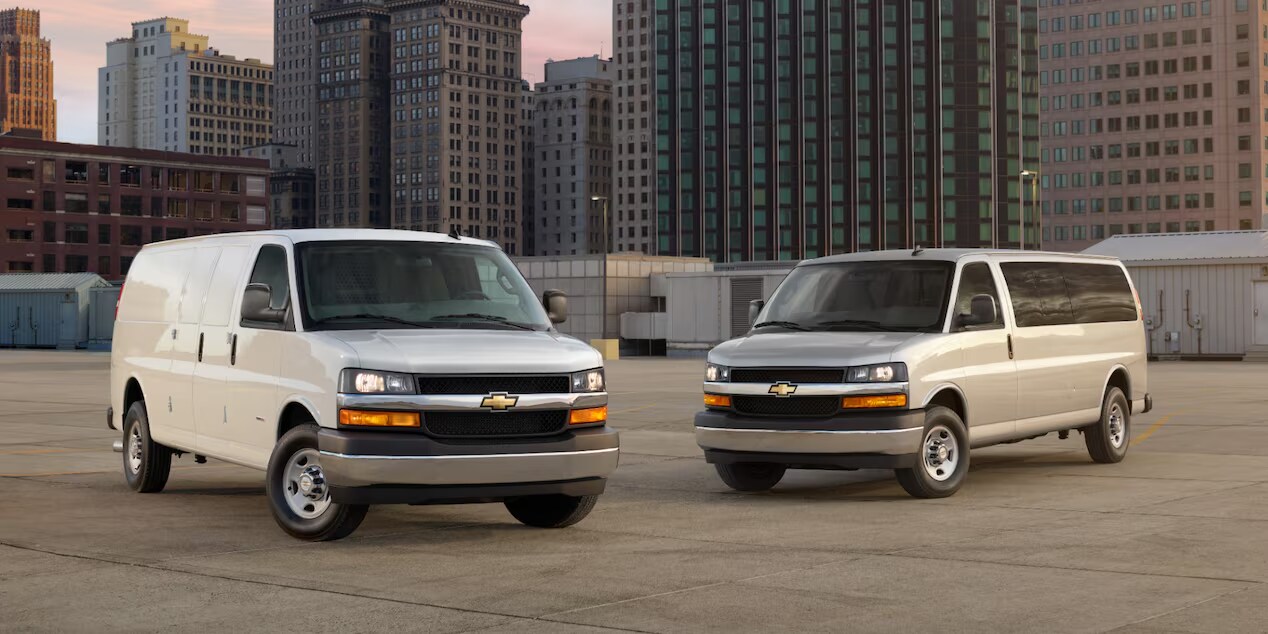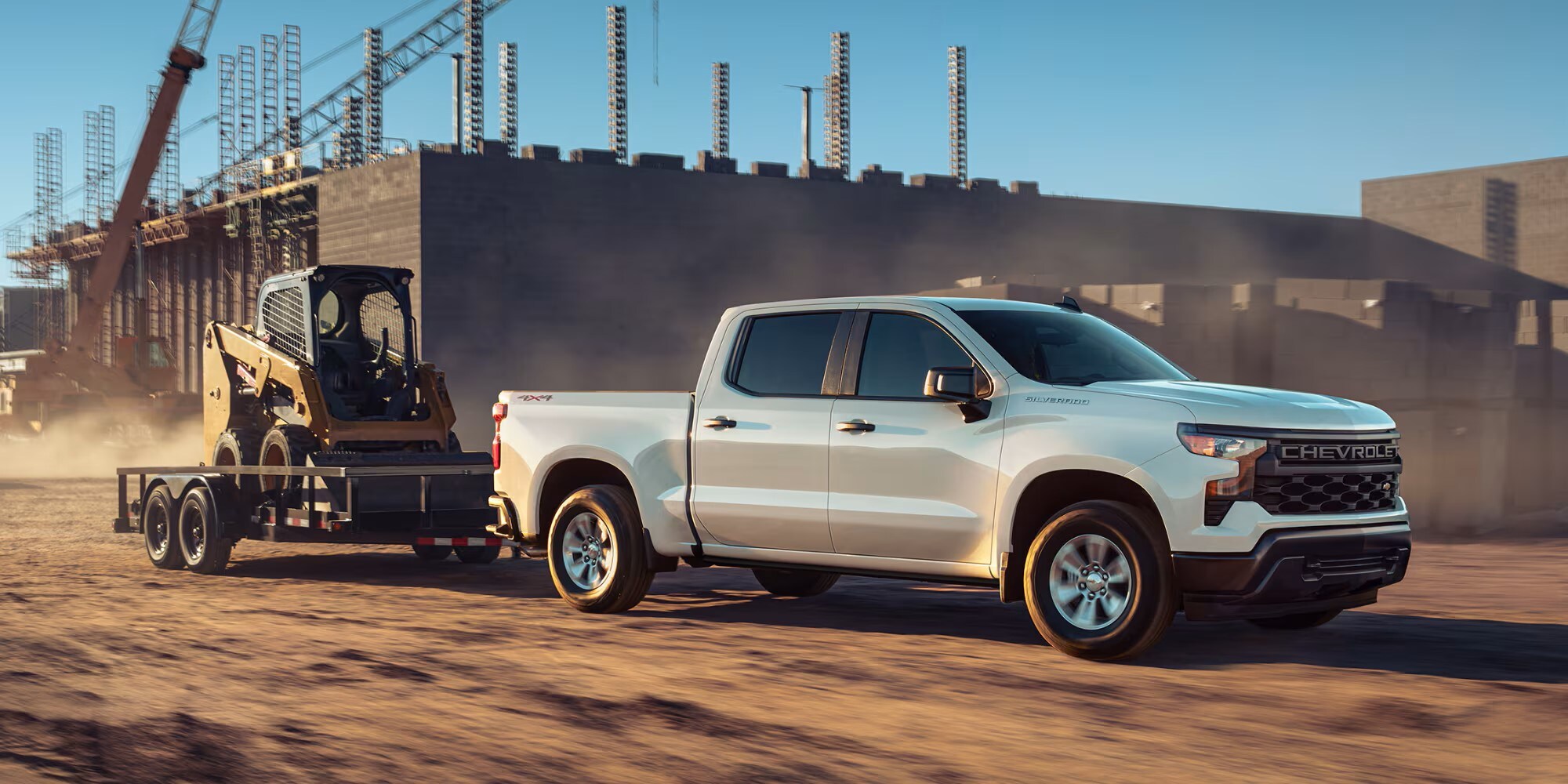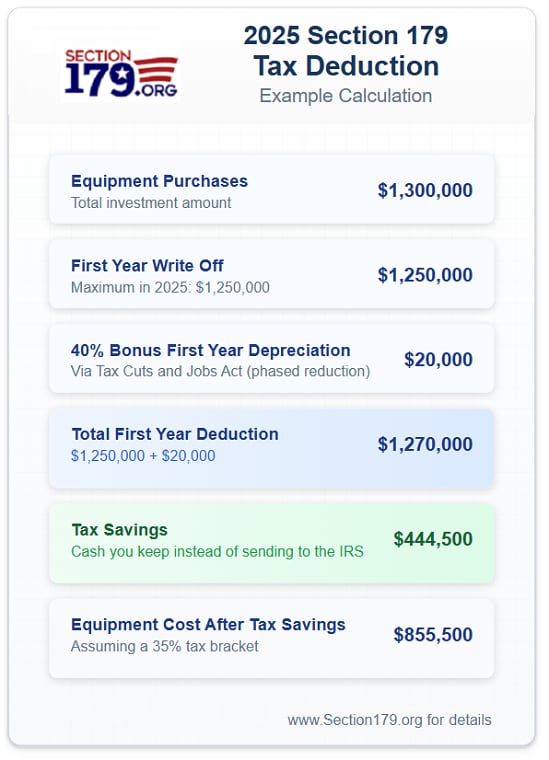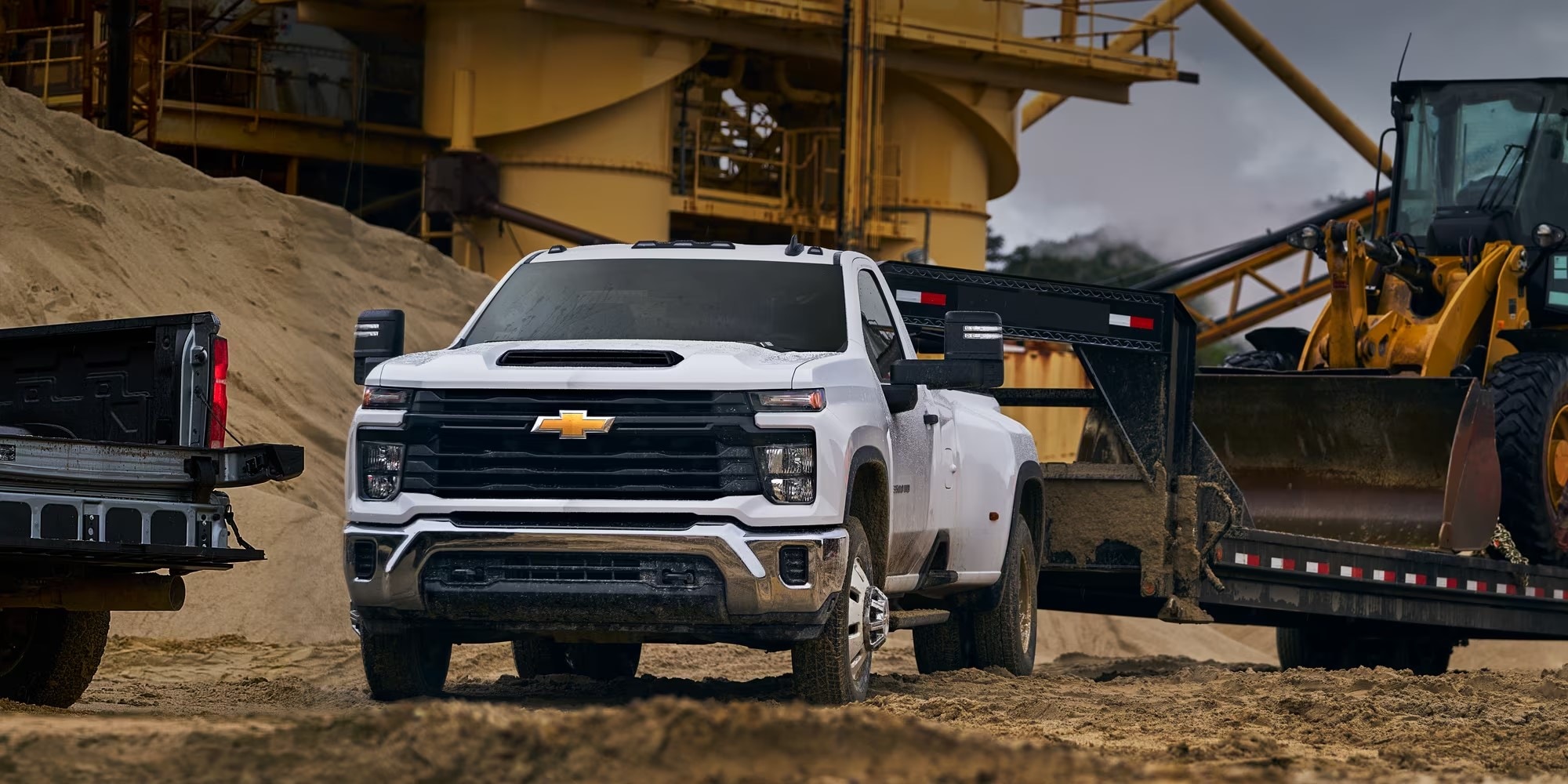Keep More of Your Money with the Section 179 Tax Deduction
The 2025 Section 179 tax deduction enables businesses to immediately write off up to $1,250,000 in qualifying equipment purchases-rather than depreciating them over many years. This powerful business tax incentive applies to both new and used equipment, vehicles, software, and certain improvements, allowing you to invest in growth while significantly reducing your tax liability. Whether you're upgrading manufacturing machinery, adding vehicles, or modernizing office technology, Section 179 helps small and medium-sized businesses save money while expanding operations. Since 2007, Section179.Org has been your trusted independent resource for maximizing Section 179 deductions through expert guidance on equipment eligibility, IRS requirements, and strategic financing options.
Section 179 Tax Deductions
Transform your business purchases into immediate tax savings with Section 179. This comprehensive guide explains how to maximize the 2025 deduction limits and preserve your company's cash flow.
Quick Reference: 2025 Section 179 Limits
Max Deduction (2025): 1,250,000 (phased out above $3,130,000)
Bonus Depreciation (2025): 40% (applies after Section 179)
New & Used Equipment: Qualifies for full Section 179 deduction
Specialized (Non‐Passenger) Vehicles: No special limit (treated like equipment)
SUVs & Trucks >6,000 lbs GVWR: $31,300 max first‐year Section 179; remainder depreciated
Business‐Use Requirement: 50% business use; deduction limited to % of business use

What Is Section 179 (and Why Does It Matter in 2025)?
Section 179 of the Internal Revenue Code empowers businesses to deduct the full purchase price of qualifying equipment and software in the same tax year they're put into service. Instead of stretching depreciation across several years, you can claim the entire cost upfront-dramatically improving your cash flow and creating immediate tax benefits.
Why Section 179 Matters for Your Business
- Immediate Tax Impact: Rather than waiting years for depreciation benefits, claim the full deduction in 2025
- Enhanced Cash Flow: Keep more working capital in your business when you need it most
- Strategic Growth: Upgrade equipment sooner and maintain competitive advantages in your market
How the 2025 Deduction Limits and Phase‐Out Threshold Work
What Is the Maximum Section 179 Deduction for 2025?
For 2025, businesses can deduct up to $1,250,000 in qualifying purchases. This represents the total amount you can write off immediately, provided your equipment meets these key criteria:
- Placed in service during the 2025 tax year
- Used for business purposes more than 50% of the time
- Qualifies under IRS guidelines
Spending Cap and Phase-Out Rules
The Section 179 deduction begins to phase out when your equipment purchases exceed $3,130,000:
- Dollar-for-dollar reduction above $3,130,000
- Complete phase-out at $4,380,000
- Additional purchases may still qualify for bonus depreciation
How Does Section 179 Apply to Business Vehicles?
Special rules apply to vehicles:
- Vehicles rated at 6,000 lbs. GVWR or less follow standard depreciation rules
- SUVs over 6,000 lbs. GVWR but under 14,000 lbs. GVWR: Limited to $31,300 Section 179 deduction
- Vehicles over 6,000 lbs. GVWR such as heavy work trucks and vans may be eligible for full Section 179 expensing
- Vehicles with beds at least six feet long are not subject to the SUV limitation
Learn more about Section 179 Vehicle Deductions

How Do Carryover & Limitations Work?
Your Section 179 deduction cannot exceed your business's net taxable income. However, if your Section 179 election exceeds your taxable business income in a given year, you can choose a partial Section 179 election. Any unused portion of the deduction carries forward to subsequent tax years, allowing you to apply it once you have sufficient income. This means if you can't fully utilize Section 179 in the current year, you retain the remaining deduction for future use-ensuring you never lose the benefit.
Example: How Does Section 179 Generate Tax Savings?
This example illustrates how Section 179 can dramatically reduce your after-tax equipment costs. For a $1,300,000 purchase:
- Section 179 Deduction: $1,250,000
- Bonus Depreciation: $20,000
- Total Tax Savings: $444,500 (at 35% tax bracket)
- Final Equipment Cost: $855,500


Which Assets Qualify for Section 179 in 2025?
Common Eligible Assets
- Manufacturing equipment and machinery
- Business vehicles
- Computers and office technology
- Off-the-shelf software
- Office furniture and equipment
- Certain building improvements
What Are the Requirements for Qualifying Property?
- Must be primarily for business use (>50%)
- New or used equipment qualifies
- Must be placed in service by December 31, 2025
- Cannot be inherited or gifted property

How to Plan Your Section 179 Strategy
What Is Section 179 Qualified Financing?
Take advantage of specialized Section 179 Qualified Financing to maximize your tax benefits while preserving working capital:
- Minimal down payments with flexible terms aligned to your cash flow
- Claim full Section 179 deduction even on financed equipment
- Tax savings often exceed your first-year payments
- Quick approvals to ensure December 31 deadline compliance
- Financing structures designed specifically for Section 179-eligible purchases
Many equipment vendors offer Section 179 Qualified Financing packages specifically designed for Section 179‐eligible purchases:
- Extended payment terms
- Seasonal payment schedules
- Deferred payment options
- Equipment delivery guarantees before year-end
How Does Section 179 Compare to Bonus Depreciation in 2025?
- Section 179: $1,250,000 maximum with business income limitation
- Bonus Depreciation: 40% with no income limit
- Optimal Strategy: Often involves combining both for maximum tax benefit
What Records Are Needed for a Section 179 Claim?
Maintain thorough records including:
- Purchase invoices and contracts
- Proof of payment
- Installation or in-service dates
- Business usage logs
- Form 4562 filing documentation
How Do State Tax Laws Affect Section 179 in 2025?
The federal Section 179 deduction allows up to $1,250,000 in 2025 (phasing out at $3,130,000), but states vary in their approach. While some follow federal rules exactly, others limit or prohibit these deductions. Businesses operating in multiple states need to understand each state's specific rules to plan effectively. Since tax laws change frequently, verify current guidelines with your state's Department of Revenue or tax advisor.
How Do I Make the Section 179 Election in 2025?
File Form 4562 with your tax return:
- List qualifying property
- Specify amount to expense
- Include business-use percentage
- Document vehicle information if applicable
What Are Expert Tips for Maximizing Section 179 in 2025?
- Plan Major Purchases Around Tax Years: Time your acquisitions to maximize immediate write‐offs.
- Track Business Usage Carefully: Logging usage is crucial for vehicles and other assets.
- Consider State Tax Implications: Different states may have unique limits or rules.
- Maintain Detailed Records: Keep documentation for five+ years in case of audit.
- Review Annually with a Tax Professional: Tax laws can shift year to year; stay current.
How to Maximize Your 2025 Business Vehicle Write-Offs Under Section 179
Section 179 allows businesses to immediately deduct the full cost of qualifying vehicle purchases in the year they are placed in service, rather than spreading the deduction over multiple years. This tax benefit can significantly reduce your 2025 tax liability while improving cash flow - especially for businesses that rely on heavy-duty work vehicles or specialized vehicles.
By leveraging Section 179, business owners can maximize tax savings while keeping operations efficient. Below, we break down key eligibility requirements, deduction limits, and best practices to ensure compliance.
2025 Section 179 Vehicle Deductions At-a-Glance
New & Used Vocational Trucks and Vans: Full Section 179 deduction available
Heavy SUVs & Trucks (Over 6,000 lbs GVW): $31,300 maximum Section 179
Cars, Light Trucks & SUVs (Under 6,000 lbs): $20,400 first-year maximum
Business Use Minimum: Must exceed 50% business use
Purchase / Finance Deadline: Must be in service by December 31, 2025
Additional Bonus Depreciation: 40% available for 2025
2025 Section 179 Deduction Limits Explained
For 2025, the total deduction phase-out begins when total equipment purchases exceed $3,130,000, reducing dollar-for-dollar beyond this threshold. Different vehicle types have additional rules and deduction caps, which we'll explore below.
*Important Note on 2025 Figures: The Section 179 limits and luxury auto caps referenced in this guide are projections based on expected inflation adjustments for 2025. Final figures are subject to official IRS publication, which may slightly differ.*
Three Vehicle Categories Under Section 179
1. Vocational/Specialized Vehicles (Any Weight) or Over 14,000 lb. (Full Deduction)
These vehicles generally have no personal-use function and typically qualify for the full Section 179 deduction (up to $1,250,000) in 2025, provided overall spending limits are not exceeded. Although many owners of true commercial vehicles do not track mileage the same way passenger‑vehicle owners do, it's still wise to maintain basic purchase/financing documentation to support business ownership.

Qualifying examples include:
- Heavy trucks over 14,000 lb. GVWR used in construction or hauling
- Specialized equipment (cement mixers, garbage trucks, cranes, forklifts, skid steers)
- Buses designed for 20+ passengers behind the driver's seat
- Delivery trucks with minimal passenger seating
- Cargo vans with permanent commercial modifications (e.g., enclosed cargo area, no seating behind driver)
- Tractors and special‑purpose farm vehicles
- Special‑purpose vehicles like ambulances and hearses
Example: A business purchasing a $120,000 commercial truck (>14,000 lb.) can potentially deduct the entire amount in 2025, assuming >50% business use and staying within overall spending limits.
2. Heavier Passenger Vehicles (6,000-14,000 lb. GVWR)
SUVs, trucks, and vans in this weight class have a special $31,300 Section 179 cap for 2025. The remaining cost above $31,300 may qualify for 40% bonus depreciation in 2025.
Example Calculation:
- Vehicle Cost: $75,000 SUV (>6,000 lb.)
- Section 179 Deduction: $31,300
- Remaining $43,700: Eligible for 40% bonus depreciation ($17,480)
- Total First‑Year Deduction: $48,780

3. Cars & Light Trucks (Under 6,000 lb. GVWR)
Traditional passenger vehicles face a first‑year deduction cap of $20,400 (2025 estimate, until IRS releases official limits) when used 100% for business. This scales with your business‑use percentage 80% business use means a maximum deduction of $16,320.
Business‑Use Requirements & Deadlines
To qualify for Section 179:
- Over 50% Business Use: Exactly 50% doesn't qualify. Track detailed mileage or usage logs if there's any chance of personal use.
- Taxable Income Limitation: Keep in mind that your Section 179 deduction cannot exceed your business income in the same tax year. Any unused deduction generally carries forward to future years.
- Ownership & Title: Title the vehicle in your company's name.
- In‑Service Date: Must be purchased (or financed) and actively used by December 31, 2025.
- Maintaining Usage: Vehicle business use should remain above 50% over its class life (generally 5 years) or recapture rules may apply.
Important Notes:
- New & Used Vehicles: Section 179 applies to both new and used vehicles-provided they're "new to you" and purchased in an arms‑length transaction.
- Recapture Risk: If business use drops below 50% in future years-or if you sell the vehicle prematurely-the IRS may "recapture" part of your deduction.
- State Variations: Some states do not fully conform to federal Section 179 rules. Check our State Conformity page for details.
- Class Life Tracking: Vehicles typically have a 5‑year class life for tax purposes; maintain usage records throughout this period.
Common Pitfalls to Avoid
- Overstating Business Use - Don't claim 100% if you occasionally run personal errands. Maintain accurate and detailed logs.
- Misunderstanding SUV Rules - Simply exceeding 6,000 lb. GVWR does not guarantee full deductions for passenger‑type vehicles.
- Not Titling the Vehicle in Business Name - Failing to title in your business name can complicate IRS compliance.
- Missing Deadlines - Ensure the purchase, financing, and in-service date occur before December 31, 2025.
- Ignoring State Rules - Some states limit Section 179 differently. Check our State Conformity page.
Disclaimer: Page content provided by Section179.Org. Page content is illustrative and not guaranteed accurate. This guide provides general information about Section 179 and is not tax advice. Always consult qualified tax professionals regarding your specific circumstances. Section179.Org is an independent resource dedicated to clarifying the Section 179 Tax Deduction and explaining how federal stimulus measures affect your business but is not affiliated with the IRS. This guide is for general information only and should not replace professional tax advice; consult a qualified professional for personalized guidance.
How Can We Help?
* Indicates a required field
-
Hawthorne Chevrolet
1180 GOFFLE RD
HAWTHORNE, NJ 07506
- Sales: (800) 816-5804